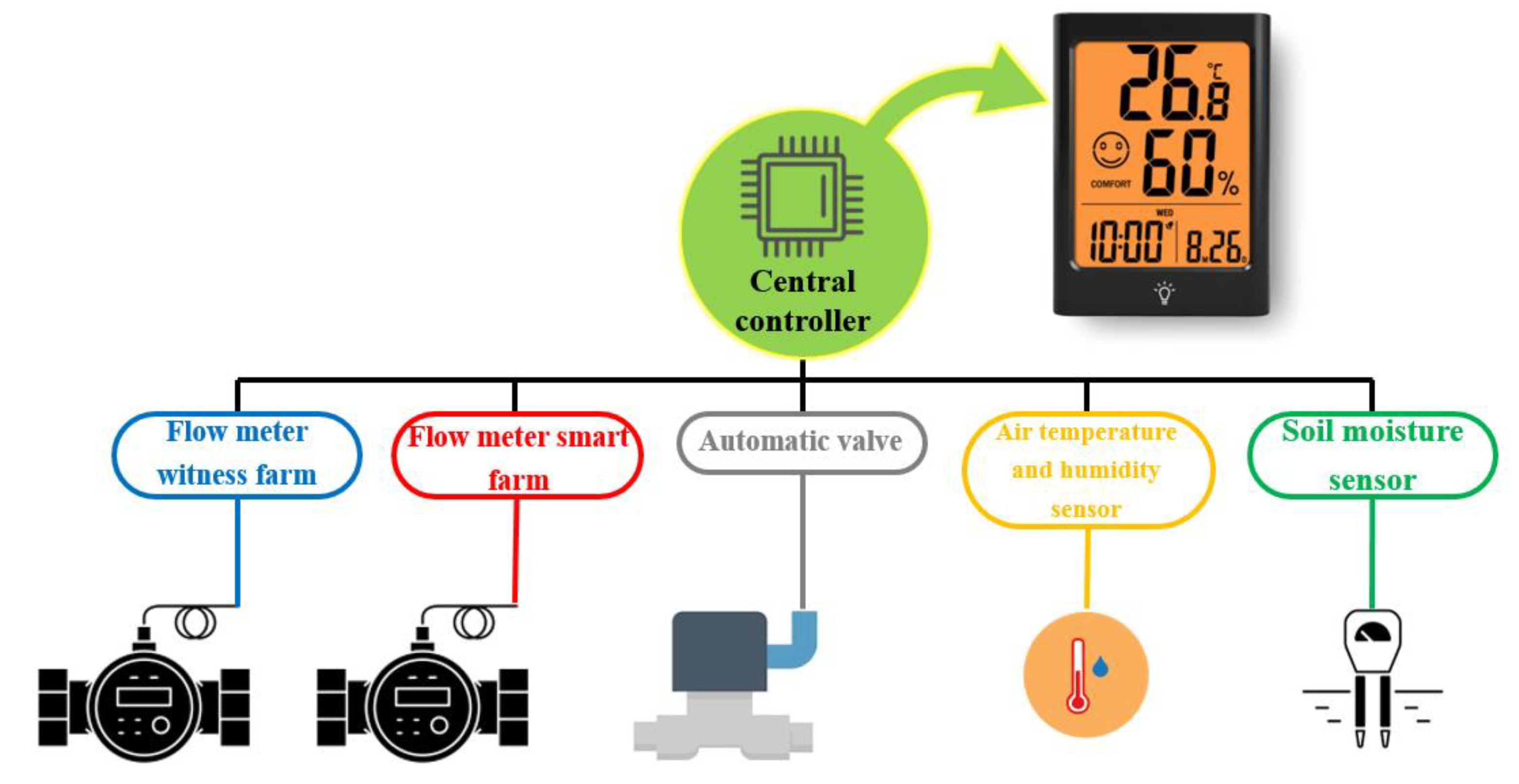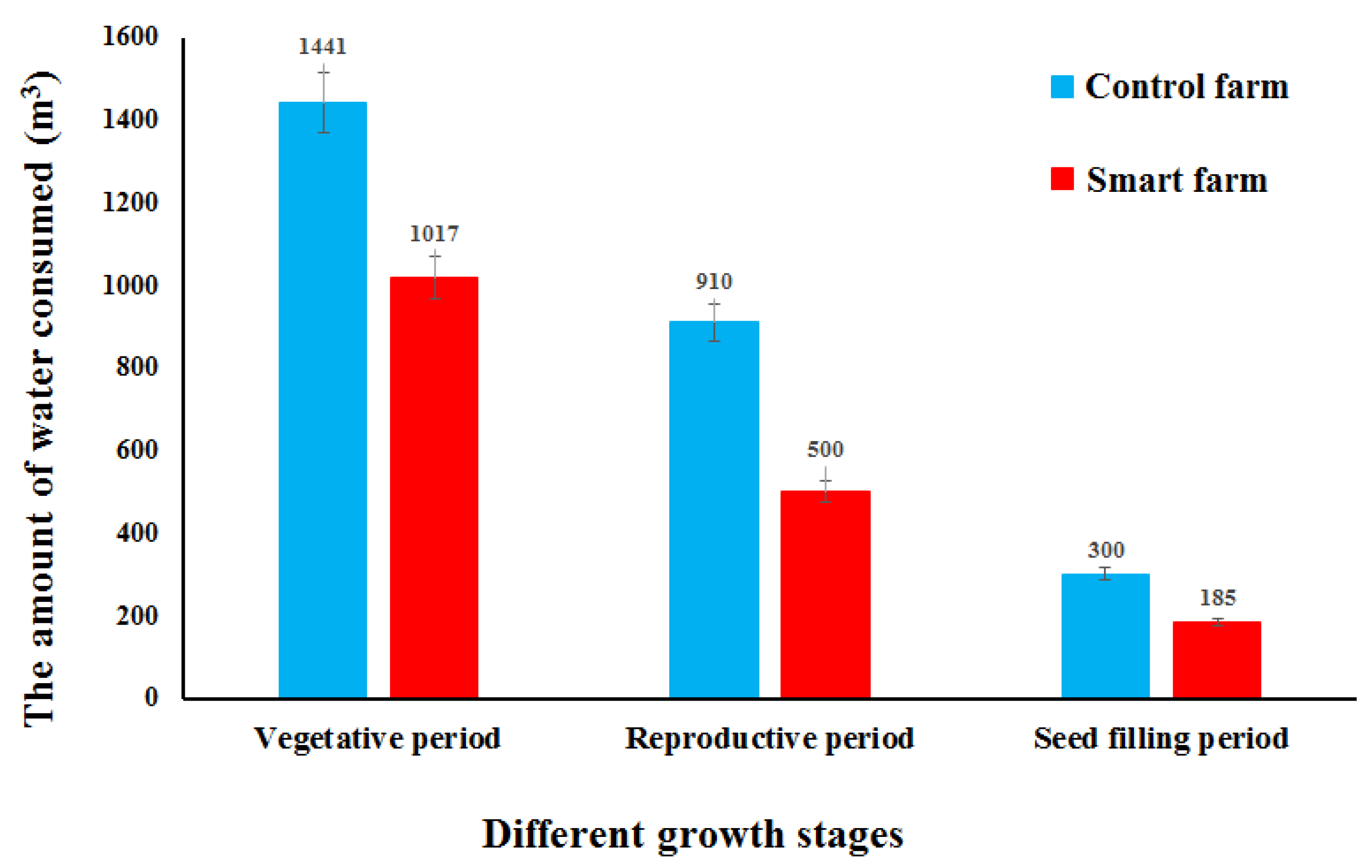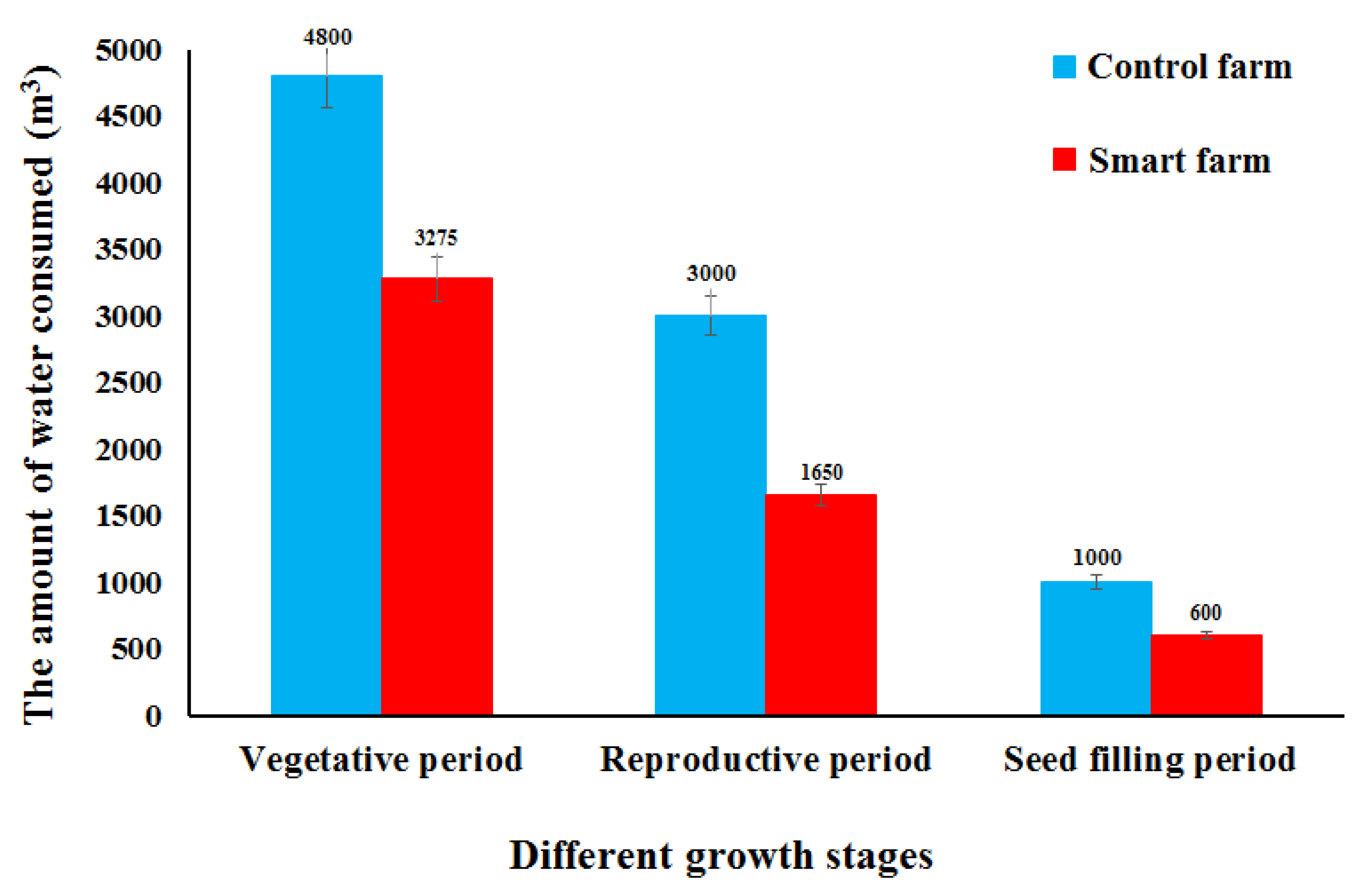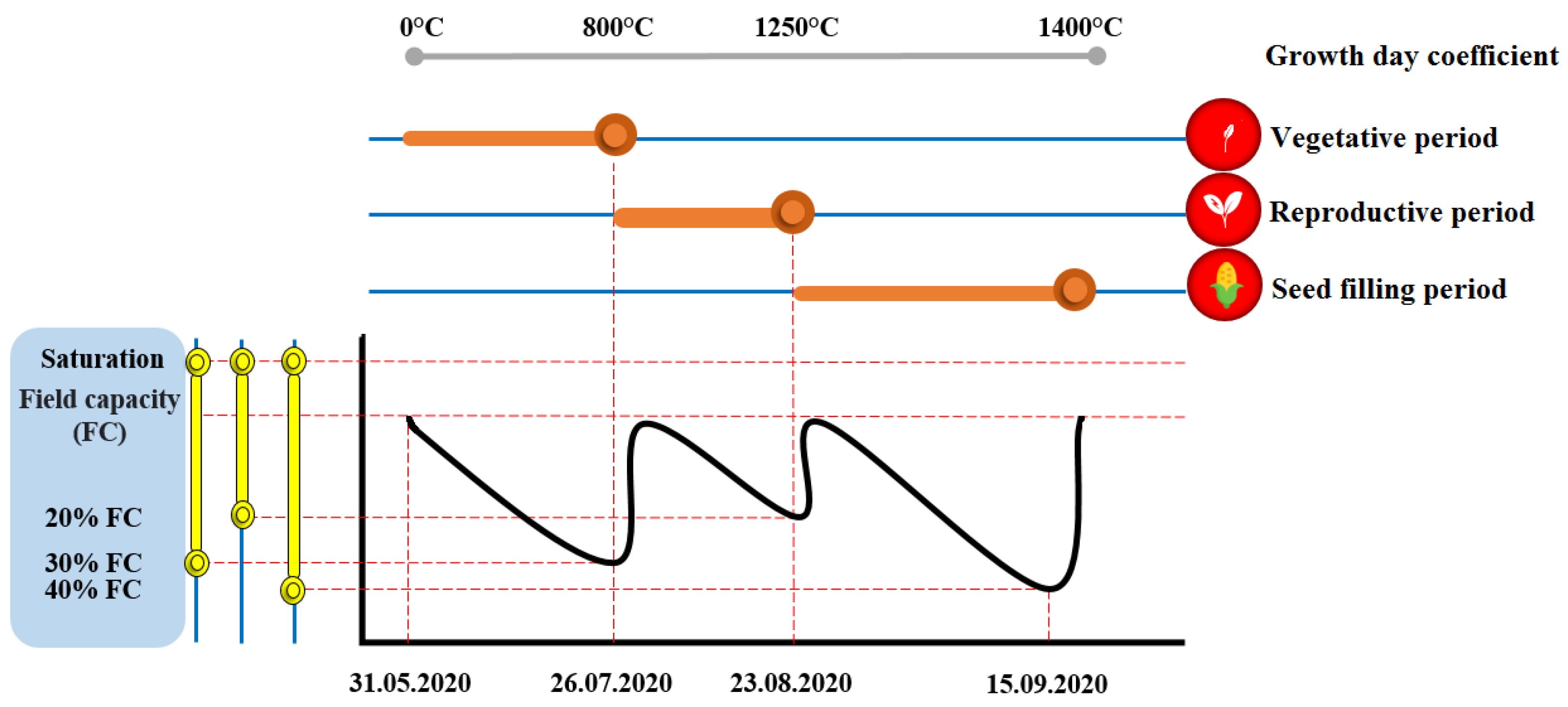Evaluating the Use of Intelligent Irrigation Systems Based on the IoT in Grain Corn Irrigation
Abstract
1. Introduction
2. Materials and Methods
2.1. Study Area
2.2. Product Application Panel and Intelligent System
2.3. Determination of Irrigation Timing
2.4. Statistical Analysis
3. Results and Discussion
3.1. Morphological Features
3.2. Irrigation Water
3.3. Savings in the Water Balance Used
3.4. Time Monitoring of Decision Data
3.5. Analysis of the Number of Moisture Sensors
4. Conclusions
Author Contributions
Funding
Data Availability Statement
Acknowledgments
Conflicts of Interest
References
- Salari, K.; Zarafshan, P.; Khashehchi, M.; Chegini, G.; Etezadi, H.; Karami, H.; Szulżyk-Cieplak, J.; Łagód, G. Knowledge and Technology Used in Capacitive Deionization of Water. Membranes 2022, 12, 459. [Google Scholar] [CrossRef] [PubMed]
- Ashraf, S.; Nazemi, A.; AghaKouchak, A. Anthropogenic drought dominates groundwater depletion in Iran. Sci. Rep. 2021, 11, 9135. [Google Scholar] [CrossRef] [PubMed]
- García, L.; Parra, L.; Jimenez, J.M.; Lloret, J.; Lorenz, P. IoT-Based Smart Irrigation Systems: An Overview on the Recent Trends on Sensors and IoT Systems for Irrigation in Precision Agriculture. Sensors 2020, 20, 1042. [Google Scholar] [CrossRef] [PubMed]
- Iglesias, A.; Santillán, D.; Garrote, L. On the barriers to adaption to less water under climate change: Policy choices in Mediterranean countries. Water Resour. Manag. 2018, 32, 4819–4832. [Google Scholar] [CrossRef]
- Hoekstra, A.Y.; Mekonnen, M.M. The water footprint of humanity. Proc. Natl. Acad. Sci. USA 2012, 109, 3232–3237. [Google Scholar] [CrossRef]
- Tatli, S.; Mirzaee-Ghaleh, E.; Rabbani, H.; Karami, H.; Wilson, A.D. Prediction of Residual NPK Levels in Crop Fruits by Electronic-Nose VOC Analysis following Application of Multiple Fertilizer Rates. Appl. Sci. 2022, 12, 11263. [Google Scholar] [CrossRef]
- Tatli, S.; Mirzaee-Ghaleh, E.; Rabbani, H.; Karami, H.; Wilson, A.D. Rapid Detection of Urea Fertilizer Effects on VOC Emissions from Cucumber Fruits Using a MOS E-Nose Sensor Array. Agronomy 2022, 12, 35. [Google Scholar] [CrossRef]
- Farooq, U. Revolutionizing Pakistan Agriculture by Increasing the Use of Knowledge, Science and Technology and ICTs. In Building Knowledge-Based Economy in Pakistan: Learning from Best Practices; Islamabad Policy Research Institute: Islamabad, Pakistan, 2016. [Google Scholar]
- Obaideen, K.; Yousef, B.A.A.; AlMallahi, M.N.; Tan, Y.C.; Mahmoud, M.; Jaber, H.; Ramadan, M. An overview of smart irrigation systems using IoT. Energy Nexus 2022, 7, 100124. [Google Scholar] [CrossRef]
- Zia, H.; Rehman, A.; Harris, N.R.; Fatima, S.; Khurram, M. An Experimental Comparison of IoT-Based and Traditional Irrigation Scheduling on a Flood-Irrigated Subtropical Lemon Farm. Sensors 2021, 21, 4175. [Google Scholar] [CrossRef]
- FAO; IFAD; UNICEF; WFP; WHO. The State of Food Security and Nutrition in the World 2020. Transforming Food Systems for Affordable Healthy Diets; Food and Agriculture Organization of the United Nations: Rome, Italy, 2020.
- Cays, J. The Energy Essential: Physical Forces Animate All Things. In An Environmental Life Cycle Approach to Design: LCA for Designers and the Design Market; Cays, J., Ed.; Springer International Publishing: Cham, Switzerland, 2021; pp. 15–38. [Google Scholar]
- Salam, A. Internet of Things in Agricultural Innovation and Security. In Internet of Things for Sustainable Community Development: Wireless Communications, Sensing, and Systems; Salam, A., Ed.; Springer International Publishing: Cham, Switzerland, 2020; pp. 71–112. [Google Scholar]
- Khriji, S.; El Houssaini, D.; Kammoun, I.; Kanoun, O. Precision Irrigation: An IoT-Enabled Wireless Sensor Network for Smart Irrigation Systems. In Women in Precision Agriculture: Technological Breakthroughs, Challenges and Aspirations for a Prosperous and Sustainable Future; Hamrita, T.K., Ed.; Springer International Publishing: Cham, Switzerland, 2021; pp. 107–129. [Google Scholar]
- Dhanaraju, M.; Chenniappan, P.; Ramalingam, K.; Pazhanivelan, S.; Kaliaperumal, R. Smart Farming: Internet of Things (IoT)-Based Sustainable Agriculture. Agriculture 2022, 12, 1745. [Google Scholar] [CrossRef]
- Tsouros, D.C.; Bibi, S.; Sarigiannidis, P.G. A review on UAV-based applications for precision agriculture. Information 2019, 10, 349. [Google Scholar] [CrossRef]
- Munir, M.S.; Bajwa, I.S.; Ashraf, A.; Anwar, W.; Rashid, R. Intelligent and smart irrigation system using edge computing and IoT. Complexity 2021, 2021, 6691571. [Google Scholar] [CrossRef]
- Barkunan, S.R.; Bhanumathi, V.; Sethuram, J. Smart sensor for automatic drip irrigation system for paddy cultivation. Comput. Electr. Eng. 2019, 73, 180–193. [Google Scholar] [CrossRef]
- Goap, A.; Sharma, D.; Shukla, A.K.; Krishna, C.R. An IoT based smart irrigation management system using Machine learning and open source technologies. Comput. Electron. Agric. 2018, 155, 41–49. [Google Scholar] [CrossRef]
- Kamienski, C.; Soininen, J.-P.; Taumberger, M.; Dantas, R.; Toscano, A.; Salmon Cinotti, T.; Filev Maia, R.; Torre Neto, A. Smart water management platform: IoT-based precision irrigation for agriculture. Sensors 2019, 19, 276. [Google Scholar] [CrossRef]
- Nawandar, N.K.; Satpute, V.R. IoT based low cost and intelligent module for smart irrigation system. Comput. Electron. Agric. 2019, 162, 979–990. [Google Scholar] [CrossRef]
- Munir, M.S.; Bajwa, I.S.; Naeem, M.A.; Ramzan, B. Design and implementation of an IoT system for smart energy consumption and smart irrigation in tunnel farming. Energies 2018, 11, 3427. [Google Scholar] [CrossRef]
- Geiser, K.; Slack, D.; Allred, E.; Stange, K. Irrigation scheduling using crop canopy-air temperature difference. Trans. ASAE 1982, 25, 689–0694. [Google Scholar] [CrossRef]
- Ghinassi, G.; Giacomin, A.; Poli, E. Irrigation Management at Field Level: Tensiometer Utilization for Performance Control. In Improved Irrigation Technologies and Methods: Research, Development and Testing, Proceedings of the ICID International Workshop, Montpellier, France, 14–19 September 2003; International Commission on Irrigation and Drainage(ICID): New Delhi, India, 2003. [Google Scholar]
- Incrocci, L.; Marzialetti, P.; Incrocci, G.; Di Vita, A.; Balendonck, J.; Bibbiani, C.; Spagnol, S.; Pardossi, A. Substrate water status and evapotranspiration irrigation scheduling in heterogenous container nursery crops. Agric. Water Manag. 2014, 131, 30–40. [Google Scholar] [CrossRef]
- Ferrarezi, R.S.; Peng, T.W. Smart System for Automated Irrigation Using Internet of Things Devices. HortTechnology 2021, 31, 642–649. [Google Scholar] [CrossRef]
- Mohammed, M.; Riad, K.; Alqahtani, N. Efficient IoT-Based Control for a Smart Subsurface Irrigation System to Enhance Irrigation Management of Date Palm. Sensors 2021, 21, 3942. [Google Scholar] [CrossRef] [PubMed]
- Ramachandran, V.; Ramalakshmi, R.; Kavin, B.P.; Hussain, I.; Almaliki, A.H.; Almaliki, A.A.; Elnaggar, A.Y.; Hussein, E.E. Exploiting IoT and Its Enabled Technologies for Irrigation Needs in Agriculture. Water 2022, 14, 719. [Google Scholar] [CrossRef]
- Cheng, M.; Wang, H.; Fan, J.; Zhang, F.; Wang, X. Effects of Soil Water Deficit at Different Growth Stages on Maize Growth, Yield, and Water Use Efficiency under Alternate Partial Root-Zone Irrigation. Water 2021, 13, 148. [Google Scholar] [CrossRef]
- Huang, C.; Ma, S.; Gao, Y.; Liu, Z.; Qin, A.; Zhao, B.; Ning, D.; Duan, A.; Liu, X.; Chen, H.; et al. Response of Summer Maize Growth and Water Use to Different Irrigation Regimes. Agronomy 2022, 12, 768. [Google Scholar] [CrossRef]
- Bazaluk, O.; Havrysh, V.; Nitsenko, V.; Mazur, Y.; Lavrenko, S. Low-Cost Smart Farm Irrigation Systems in Kherson Province: Feasibility Study. Agronomy 2022, 12, 1013. [Google Scholar] [CrossRef]
- Mahrokh, A.; Nabipour, M.; Roshanfekr, H.A.; Choukan, R. Response of some grain maize physiological parameters to drought stress and application of auxin and cytokinin hormones. Environ. Stress. Crop Sci. 2019, 12, 1–15. [Google Scholar] [CrossRef]
- Muleke, A.; Harrison, M.; Voil, P.; Hunt, I.; Liu, K.; Yanotti, M.; Eisner, R. Earlier crop flowering caused by global warming alleviated by irrigation. Environ. Res. Lett. 2022, 17, 044032. [Google Scholar] [CrossRef]
- Zabihi Afrooz, R.A.; Emami, J.; Hosseinitab, S.M.; Javafshan-Vishkani, S. National Water Document: Net Plant Water Requirement (Viewing System) (Plant Information and Data); Planning Research Institute, Agricultural Economics and Rural Development, Research Services Management: Tehran, Iran, 2016. [Google Scholar]
- De Araujo Rufino, C.; Fernandes-Vieira, J.; Martín-Gil, J.; Abreu Júnior, J.D.S.; Tavares, L.C.; Fernandes-Correa, M.; Martín-Ramos, P. Water Stress Influence on The Vegetative Period Yield Components of Different Maize Genotypes. Agronomy 2018, 8, 151. [Google Scholar] [CrossRef]
- Gong, L.; Yan, J.; Chen, Y.; An, J.; He, L.; Zheng, L.; Zou, Z. An IoT-based intelligent irrigation system with data fusion and a self-powered wide-area network. J. Ind. Inf. Integr. 2022, 29, 100367. [Google Scholar] [CrossRef]
- Intrigliolo, D.; Castel, J. Performance of various water stress indicators for prediction of fruit size response to deficit irrigation in plum. Agric. Water Manag. 2006, 83, 173–180. [Google Scholar] [CrossRef]







| Total Nitrogen (%) | Absorbable Phosphorus Mg/Kg | Absorbable Potassium Mg/Kg | Field Capacity (%) | Permanent Wilting Point (%) | Apparent Specific Gravity (g/cm) | Electrical Conductivity (dS/m) | pH |
|---|---|---|---|---|---|---|---|
| 0.06 | 37 | 290 | 25.85 | 11.07 | 1.36 | 0.7 | 7.5 |
| Experimental Parameters | Control Farm | Smart Farm |
|---|---|---|
| Days to corolla appearance | 64 | 63 |
| Days to pollination | 64 | 65 |
| Days to the silk emergence | 71 | 69 |
| The interval between pollination and silk emergence | 5 | 4 |
| Days to harvest | 171 | 141 |
| Seed moisture (%) | 40.15 | 33.8 |
| Hectoliter (g/cm3) | 722 | 717 |
| Water consumption (m3/ha) | 8839.50 | 5676.67 |
| Water efficiency (kg/m3) | 0.86 | 0.66 |
| Experimental Parameters | Control Farm | Smart Farm | Standard Error | Probability Level |
|---|---|---|---|---|
| Height (cm) | 163.22 | 183.30 | 7.06 | ** |
| Stem diameter (cm) | 1.44 | 1.56 | 0.07 | ns |
| Leaf number | 13.97 | 14.55 | 0.27 | * |
| Comb length (cm) | 18.53 | 18.51 | 0.63 | ns |
| Comb diameter (cm) | 4.71 | 4.42 | 0.10 | ** |
| Number of seed rows | 17.7 | 17.45 | 0.39 | ns |
| The number of seeds in the row | 40.15 | 33.8 | 1.38 | ** |
Disclaimer/Publisher’s Note: The statements, opinions and data contained in all publications are solely those of the individual author(s) and contributor(s) and not of MDPI and/or the editor(s). MDPI and/or the editor(s) disclaim responsibility for any injury to people or property resulting from any ideas, methods, instructions or products referred to in the content. |
© 2023 by the authors. Licensee MDPI, Basel, Switzerland. This article is an open access article distributed under the terms and conditions of the Creative Commons Attribution (CC BY) license (https://creativecommons.org/licenses/by/4.0/).
Share and Cite
Sharifnasab, H.; Mahrokh, A.; Dehghanisanij, H.; Łazuka, E.; Łagód, G.; Karami, H. Evaluating the Use of Intelligent Irrigation Systems Based on the IoT in Grain Corn Irrigation. Water 2023, 15, 1394. https://doi.org/10.3390/w15071394
Sharifnasab H, Mahrokh A, Dehghanisanij H, Łazuka E, Łagód G, Karami H. Evaluating the Use of Intelligent Irrigation Systems Based on the IoT in Grain Corn Irrigation. Water. 2023; 15(7):1394. https://doi.org/10.3390/w15071394
Chicago/Turabian StyleSharifnasab, Hooman, Ali Mahrokh, Hossein Dehghanisanij, Ewa Łazuka, Grzegorz Łagód, and Hamed Karami. 2023. "Evaluating the Use of Intelligent Irrigation Systems Based on the IoT in Grain Corn Irrigation" Water 15, no. 7: 1394. https://doi.org/10.3390/w15071394
APA StyleSharifnasab, H., Mahrokh, A., Dehghanisanij, H., Łazuka, E., Łagód, G., & Karami, H. (2023). Evaluating the Use of Intelligent Irrigation Systems Based on the IoT in Grain Corn Irrigation. Water, 15(7), 1394. https://doi.org/10.3390/w15071394







